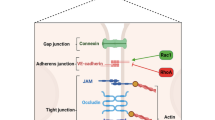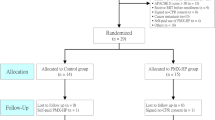Abstract
Animal models have shown that mesenteric lymph plays important roles in the pathogenesis of endothelium injury in many critical ill states. Gut-derived septicemia and endothelium injury are the two key pathogenesis of heat stroke (HS); however, it is unclear whether mesenteric lymph is cytotoxic to endothelium in HS. HS rat models were prepared in a prewarmed incubator. Mesenteric lymph, collected pre-, during, and post-HS, was analyzed for biological activity on human umbilical vein endothelial cell (HUVEC) in vitro. The effect of HS lymph on the production of von Willebrand factor (vWF), thrombomodulin (TM), and IL-6 by HUVEC was investigated. In vivo, vascular endothelium injury biomarkers, circulating endothelial cell (CEC), as well as serum soluble vWF and TM were tested in rats of HS and HS with mesenteric lymph duct ligation (HS-LDL). HS but not heat stroke sham mesenteric lymph-injured endothelial cells showed significantly increased HUVEC cytotoxicity and enhanced HUVEC monolayer permeability as well as elevated levels of vWF and TM production by HUVEC. IL-6 production by HUVEC was augmented by HS lymph in vitro. The effects of HS lymph on IL-6 production had a time course resembling that of the toxic effects of HS lymph on HUVEC. In vivo, when compared with HS rats, decreased CEC counts as well as lower serum vWF and TM concentrations were detected in HS-LDL rats. HS mesenteric lymph is probably harmful to vascular endothelium, which indicates that the modulation of mesenteric lymph may have some potential benefits to HS.






Similar content being viewed by others
REFERENCES
Bouchama, A., and J.P. Knochel. 2002. Heat stroke. New England Journal of Medicine 346: 1978–1988.
Lu, K.C., J.Y. Wang, S.H. Lin, P. Chu, and Y.F. Lin. 2004. Role of circulating cytokines and chemokines in exertional heat stroke. Critical Care Medicine 32: 399–403.
Bouchama, A., V. Ollivier, G. Roberts, et al. 2005. Experimental heat stroke in baboon: Analysis of the systemic inflammatory response. Shock 24: 332–335.
Roberts, G.T., H. Ghebeh, M.A. Chishti, F. Al-Mohanna, R. El-Sayed, F. Al-Mohanna, and A. Bouchama. 2008. Microvascular injury, thrombosis, inflammation, and apoptosis in the pathogenesis of heat stroke: A study in baboon model. Arteriosclerosis, Thrombosis, and Vascular Biology 28: 1130–1136.
Lambert, G.P. 2009. Stress-induced gastrointestinal barrier dysfunction and its inflammatory effects. Journal of Animal Science 87: 101–108.
Lambet, G.P. 2004. Role of gastrointestinal permeability in exertional heat stroke. American College of Sport Medicine 32: 185–190.
Gathiram, P., S.L. Gaffin, J.G. Brock-Utne, and M.T. Wells. 1987. Time course of endotoxemia and cardiovascular changes in heat-stressed primates. Aviation, Space, and Environmental Medicine 58: 1071–1074.
Hall, D.M., G.R. Buettner, L.W. Oberley, L. Xu, R.D. Matthes, and C.V. Gisolfi. 2001. Mechanisms of circulatory and intestinal barrier dysfunction during whole body hyperthermia. American Journal of Physiology - Heart and Circulatory Physiology 280: 509–521.
Selkirk, G.A., T.M. McLellan, H.E. Wright, and S.G. Rhind. 2008. Mild endotoxemia, NF-kappa B translocation, and cytokine increase during exertional heat stress in trained and untrained individuals. American Journal of Physiology - Regulatory, Integrative and Comparative Physiology 295: 611–623.
Gathiram, P., M.T. Wells, D. Raidoo, J.G. Brock-utne, and S.L. Gaffin. 1988. Portal and systemic plasma lipopolysaccharide concentrations in heat-stressed primates. Circulatory Shock 25: 223–230.
Deitch, E.A., R. Forsythe, D. Anjaria, D.H. Livingston, Q. Lu, D.Z. Xu, and H. Redl. 2004. The role of lymph factors in lung injury, bone marrow suppression and endothelial cell dysfunction in a primate model of trauma-hemorrhagic shock. Shock 22: 221–228.
Magnotti, L.J., J.S. Upperman, D.Z. Xu, Q. Lu, and E.A. Deitch. 1998. Gut-derived mesenteric lymph but not portal blood increases endothelial cell permeability and potentiates lung injury following hemorrhagic shock. Annals of Surgery 228: 518–527.
Chen, S.H., F.M. Chang, K.C. Niu, M.Y. Lin, and M.T. Lin. 2006. Resuscitation from experimental heat stroke by estrogen therapy. Critical Care Medicine 34(4): 1113–8.
Chen, S.H., F.M. Chang, H.K. Chang, W.C. Chen, K.F. Huang, and M.T. Lin. 2007. Human umbilical cord blood-derived CD34+ cells cause attenuation of multiorgan dysfunction during experimental heat stroke. Shock 27: 663–671.
Lee, J.J., M.T. Lin, N.L. Wang, C.L. Lin, and C.K. Chang. 2005. Platonin, a cyanine photosensitizing dye, causes attenuation of circulatory shock, hypercoagulable state, and tissue ischemia during heat stroke. Shock 24(6): 577–582.
Davidson, M.T., E.A. Deitch, Q. Lu, A. Osband, E. Feketeova, Z.H. Németh, G. Haskó, and D.Z. Xu. 2004. A study of the biologic activity of trauma-hemorrhagic shock mesenteric lymph over time and the relative role of cytokines. Surgery 136: 32–41.
Corwin, H.L., M.M. Schwartz, and E.J. Lewis. 1998. The importance of sample size in the interpretation of the renal biopsy. American Journal of Nephrology 8: 85–89.
Iwata, Y., F. Kuzuya, M. Hayakawa, M. Naito, K. Shibata, and H. Endo. 1986. Circulating endothelial cells fail to induce cerebral infarction in rabbits. Stroke 17: 506–509.
Lambert, G.P., C.V. Gisolfi, D.J. Berg, P.L. Moseley, L.W. Oberley, and K.C. Kregel. 2002. Selected contribution: Hyperthermia-induced intestinal permeability and the role of oxidative and nitrosative stress. Journal of Applied Physiology 92: 1750–1761.
Bouchama, A., G. Roberts, F. Al Mohanna, R. El-Sayed, B. Lach, S. Chollet-Martin, V. Ollivier, R. Al Baradei, A. Loualich, S. Nakeeb, A. Eldali, and D. de Prost. 2005. Inflammatory, hemostatic, and clinical changes in a baboon experimental model for heat stroke. Journal of Applied Physiology 98: 697–705.
Gathiram, P., M.T. Wells, J.G. Brock-Utne, and S.L. Gaffin. 1987. Antilipopolysaccharide improves survival in primates subjected to heat stroke. Circulatory Shock 23: 157–164.
Gathiram, P., M.T. Wells, J.G. Brock-Utne, B.C. Wessels, and S.L. Gaffin. 1988. Oral administered nonabsorbable antibiotics prevent endotoxemia in primates following intestinal ischemia. Journal of Surgical Research 45: 187–193.
Bouchama, A., M.M. Hammami, A. Haq, J. Jackson, and S. al-Sedairy. 1996. Evidence for endothelial cell activation/injury in heat stroke. Critical Care Medicine 24: 1173–1178.
Deitch, E.A. 2001. Role of the gut lymphatic system in multiple organ failure. Current Opinion in Critical Care 7: 92–8.
Fanous, M.Y., A.J. Phillips, and J.A. Windsor. 2007. Mesenteric lymph: the bridge to future management of critical illness. Journal of the Pancreas 8: 374–399.
Deitch, E.A. 2010. Gut lymph and lymphatics: A source of factors leading to organ injury and dysfunction. Annals of the New York Academy of Sciences 1207: 103–111.
Niu, C.Y., Y.L. Hou, Z.G. Zhao, Y.F. Zhang, J.J. Ji, H.X. Qiao, J. Zhang, and Y.M. Yao. 2007. Role of intestinal lymphatic pathway in pathogenesis of intestine-derived bacteria/endotoxin translocation in rats in shock. Zhongguo Wei Zhong Bing Ji Jiu Yi Xue 19: 266–9.
Ang, C., and J. Dawes. 1994. The effects of hyperthermia on human endothelial monolayers: Modulation of thrombotic potential and permeability. Blood Coagulation & Fibrinolysis 5: 193–9.
Hammami, M.M., A. Bouchama, E. Shail, H.Y. Aboul-Enein, and S. Al-Sedairy. 1998. Lymphocyte subsets and adhesion molecules expression in heat stroke and heat stress. Journal of Applied Physiology 84: 1615–21.
Park, K.J., S.H. Kang, Y.S. Chae, M.O. Yu, T.H. Cho, J.K. Suh, H.K. Lee, and Y.G. Chung. 2010. Influence of interleukin-6 on the development of peritumoral brain edema in meningiomas. Journal of Neurosurgery 112: 73–80.
Kaplanski, G., V. Marin, F. Montero-Julian, A. Mantovani, and C. Farnarier. 2003. IL-6: a regulator of the transition from neutrophil to monocyte recruitment during inflammation. Trends in Immunology 24: 25–29.
Hall, D.M., K.R. Baumgardner, T.D. Oberley, and C.V. Gisolfi. 1999. Splanchnic tissues undergo hypoxic stress during whole body hyperthermia. American Journal of Physiology 276: 1195–203.
Lambert, G.P. 2008. Intestinal barrier dysfunction, endotoxemia, and gastrointestinal symptoms: The ‘canary in the coal mine’ during exercise-heat stress? Medicine and Sport Science 53: 61–73.
Deitch, E.A., H.P. Shi, Q. Lu, E. Feketeova, and D.Z. Xu. 2003. Serine proteases are involved in the pathogenesis of trauma-hemorrhagic shock-induced gut and lung injury. Shock 19: 452–6.
Gonzalez, R.J., E.E. Moore, D.J. Ciesla, X. Meng, W.L. Biffl, and C.C. Silliman. 2001. Post-hemorrhagic shock mesenteric lymph lipids prime neutrophils for enhanced cytotoxicity via phospholipase A2. Shock. 16: 218–22.
Gonzalez, R.J., E.E. Moore, D.J. Ciesla, W.L. Biffl, P.J. Offner, and C.C. Silliman. 2001. Phospholipase A(2). Derived neutral lipids from posthemorrhagic shock mesenteric lymph prime the neutrophil oxidative burst. Surgery 130: 198–203.
Davidson, M.T., E.A. Deitch, Q. Lu, G. Haskó, B. Abungu, Z.H. Németh, S.B. Zaets, L.D. Gaspers, A.P. Thomas, and D.Z. Xu. 2004. Trauma-hemorrhagic shock mesenteric lymph induces endothelial apoptosis that involves both caspase-dependent and caspase-independent mechanisms. Annals of Surgery 240: 123–31.
Gonzalez, R.J., E.E. Moore, W.L. Biffl, D.J. Ciesla, and C.C. Silliman. 2000. The lipid fraction of post-hemorrhagic shock mesenteric lymph (PHSML) inhibits neutrophil apoptosis and enhances cytotoxic potential. Shock 14: 404–408.
Sarin, E.L., E.E. Moore, J.B. Moore, T. Masuno, J.L. Moore, A. Banerjee, and C.C. Silliman. 2004. Systemic neutrophil priming by lipid mediators in post-shock mesenteric lymph exists across species. Journal of Traumatology 57: 950–954.
Dayal, S.D., C.J. Hauser, E. Feketeova, Z. Fekete, J.M. Adams, Q. Lu, D.Z. Xu, S. Zaets, and E.A. Deitch. 2002. Shock mesenteric lymph induced rat polymorphonuclear neutrophil activation and endothelial cell injury is mediated by aqueous factors. Journal of Traumatology 52: 1048–1055.
Kaiser, V.L., Z.C. Sifri, G.S. Dikdan, T. Berezina, S. Zaets, Q. Lu, D.Z. Xu, and E.A. Deitch. 2005. Trauma-hemorrhagic shock mesenteric lymph from the rat contains a modified form of albumin that is implicated in endothelial cell toxicity. Shock 23: 417–425.
Haubitz, M., and A. Woywodt. 2004. Circulating endothelial cells and vasculitis. Internal Medicine 43: 660–667.
Mutunga, M., B. Fulton, R. Bullock, A. Batchelor, A. Gascoigne, J.I. Gillespie, and S.V. Baudouin. 2001. Circulating endothelial cells in patients with septic shock. American Journal of Respiratory and Critical Care Medicine 163: 195–200.
Lee, K.W., G.Y. Lip, M. Tayebjee, W. Foster, and A.D. Blann. 2005. Circulating endothelial cells, von Willebrand factor, interleukin-6, and prognosis in patients with acute coronary syndromes. Blood 105: 526–532.
Nakayama, T., W. Sato, A. Yoshimura, L. Zhang, T. Kosugi, M. Campbell-Thompson, H. Kojima, B.P. Croker, and T. Nakagawa. 2010. Endothelial von Willebrand factor release due to eNOS deficiency predisposes to thrombotic microangiopathy in mouse aging kidney. American Journal of Pathology 176: 2198–2208.
Hagiwara, S., H. Iwasaka, K. Goto, Y. Ochi, S. Mizunaga, T. Saikawa, and T. Noguchi. 2010. Recombinant thrombomodulin prevents heat stroke by inhibition of high-mobility group box 1 protein in sera of rats. Shock 34: 402–406.
ACKNOWLEDGMENTS
This work is supported by the National Natural Science Foundation of China (project 81101406) and Medical Research of PLA (project BWS12J108).
Author information
Authors and Affiliations
Corresponding author
Rights and permissions
About this article
Cite this article
Tong, H., Wan, P., Zhang, X. et al. Vascular Endothelial Cell Injury Partly Induced by Mesenteric Lymph in Heat Stroke. Inflammation 37, 27–34 (2014). https://doi.org/10.1007/s10753-013-9708-x
Published:
Issue Date:
DOI: https://doi.org/10.1007/s10753-013-9708-x




